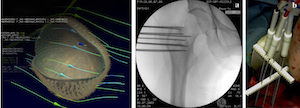Membrane peroxidation is a fundamental phenomenon in biology involved in a wide range of signaling pathways and diseases. It has been shown that external electric fields can catalyze this reaction under specific conditions. However, the underlying mechanism at the molecular level has remained elusive. In a recent study, we have built a molecular model of a hydrated lipid bilayer containing a few hydroxyl radicals (HO^.). These small molecules are relevant to lipid peroxidation in vivo because (i) they are known to be present under a variety of physiological and pathological conditions (the so-called oxidative stress), and (ii) they have the ability to initiate the free-radical chain mechanism that lead to peroxidation. By repeating molecular dynamics simulations of that system with external electric fields of various intensities, we have been able to identify a catalytic effect of the field on the initiation of the reaction. More specifically, our simulations show that hydroxyl radicals diffuse through electro-induced "water fingers" that penetrate the membrane. Following these pathways radicals can reach more easily their reactive partners located on the lipid tails in the innermost region of the bilayer.
In my talk I will first provide a general introduction of our modeling methodology. I will then present our last results regarding the catalysis of peroxidation initiation in biological membranes under the influence of external electric fields.

 PDF version
PDF version
